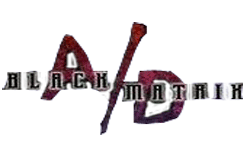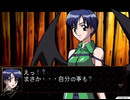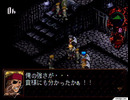|
|

|
PLATFORM
|
Dreamcast
|
BATTLE SYSTEM
|

|
INTERACTION
|

|
ORIGINALITY
|

|
STORY
|

|
MUSIC & SOUND
|

|
VISUALS
|

|
CHALLENGE
|
Adjustable
|
COMPLETION TIME
|
20-40 Hours
|
|
OVERALL

|
+ Unique tactical mechanics
+ Subtly improved over the Saturn original
+ Complex and intricate story...
- ...that was never translated thanks to its many Biblical references
- A couple of interface issues
|
Click here for scoring definitions
|
|
|
Black/Matrix appeared on the Saturn in 1998, just as that system was being killed off by Sega in preparation for the Dreamcast's launch. NEC Interchannel tried to guarantee that the game it published would have a second chance on Sega's new console, thus Black/Matrix AD (Advanced) came to be in 1999. The revised game does not take advantage of the progression in hardware very much, but manages to improve a number of aspects, thus making it superior to the original. It would have been welcome to bolster the meager tactical offerings in English on the Dreamcast, but alas it was not to be.
Black/Matrix AD begins in the way its Saturn progenitor did, with a protagonist named Abel in servitude to a woman. The player chooses the woman Abel is the servant of from five candidates, and the beginning of the game deals with the chosen woman's gradual development of feelings for him while Abel completes chores that increase statistics around her property. Eventually Abel leaves, and subsequently both are imprisoned for daring to profess feelings for each other. The world of Black/Matrix is one in which everyone has wings, and the black-winged lord over the white-winged, so Abel and his eventual lover having opposite wing colors is a threat to society's structure.
Black/Matrix's story is intricate and hard to decipher for anyone not fluent in Japanese, but it eventually transpires that Abel is a Messiah of sorts for the white-winged persons of the world. References to God and Satan are present, a man named Moses parts a sea, the seven deadly sins are cited in English on the background of the screen prior to combat, and Sodom and Gomorrah are entered, among many other moments that would have made this story a tough sell to the English-speaking world. This version has added several instances of interaction with the women not chosen by the player at the game's beginning, some FMV clips that are very helpful in learning what is transpiring, and a radically altered final portion of the game that is another direct Biblical reference.
The tactical combat is superficially similar to many other games, with an isometric perspective and characters moving around a battlefield to deliver blows to the opposing side. Veterans of other tactical series will encounter a new wrinkle with the need to administer a coup de grâce in order to kill adversaries. Any character taken to zero hit points can still be revived by any healing method, and though unable to do anything is still an impediment to movement. Landing one final blow will turn the character into a skeleton and make revival impossible, which affects both the enemy and player characters.
The means by which magic is cast also differs from the norm. Blood points are obtained by killing enemies, and are apportioned to characters from a central pool prior to battle. These blood points are needed to cast any sort of magic or special attack. Special attacks are not automatic but must be created by the player via infusion of blood into a weapon outside of battle. Normal use of magic will not drain the blood pool badly, but summoning on a frequent basis will. Summoning requires the use of blood from multiple characters congregated around the summoner, and renders all who contribute to the summon unable to move or attack for the rest of the turn.
 Never addressed in the game is how anyone is able to wear clothes that don't have holes for the wings - very strange.
Never addressed in the game is how anyone is able to wear clothes that don't have holes for the wings - very strange.
|
|
The possible stances upon being attacked also deserve mention. Each character can counterattack, evade, or defend upon being attacked. Defending minimizes damage taken, evasion is the only means of making attacks miss but will result in enormous damage if the evasion fails, and counterattacking is self-explanatory.
The isometric perspective can make it hard to see exactly what is going on in a small area, which is annoying. More annoying are the strange restrictions that enemies can mysteriously impose on character movement. For no apparent reason characters will suddenly have their movement range reduced drastically when an enemy is very close, and upon defeating that enemy the movement range will be restored to whatever it usually is.
Experience and money are awarded at the end of every battle, and as with the blood points, experience points are collected in a pool for the player to dole out. Money is not bequeathed in quantities great enough to allow players to buy anything close to all of the best equipment, making wise selections mandatory. The shop menu is easy to navigate, thankfully. Though selections can be immediately equipped from the store, doing so with weapons later in the game is unwise, because weapons cannot be infused with blood to allow special attacks when they are equipped.
Black/Matrix AD's battle visuals appear indistinguishable from its Saturn forbear, and thus do not come anywhere close to straining the Dreamcast. Character portraits have been added to the story sequences instead of relying solely upon the combat sprites, but they are unmoving. The occasional FMV is helpful for picturing the onscreen events but is technically very unimpressive, with minimal movement. The game is not ugly, but it does not strain the hardware.
 What lousy jailers, to let their captives have weapons. Punish them for this stupidity!
What lousy jailers, to let their captives have weapons. Punish them for this stupidity!
|
|
The voice acting of this game is not comprehensive, but the vast majority of story dialogue is accompanied by it. The seiyuu are of mostly good quality, though a few are content to lapse into a monotone. As for Black/Matrix's music ... the dichotomy of styles here is enormous. The soundtrack somehow seems to channel Dick Dale at one moment, Prodigy later on, and KMFDM even later. It is rarely boring, but the music is far more intriguingly eclectic than genuinely catchy.
Unlike the original Black/Matrix, this version has a difficulty select upon beginning. The ability to modulate the challenge per one's wishes makes the original's punishing later battles much more manageable if desired. The game is quite linear, but along the way many choices that affect events must be taken, so that even though the overall story is the same, many small branches invite replay, as does the choice of female companion for Abel at the beginning. The completion time is somewhere around thirty to thirty-five hours, with little leeway to stretch that number out.
It is unfortunate that Black/Matrix AD possesses so much material that would have come under fire in the English speaking world, because UFO Interactive was briefly interested in localizing the game. Flight Plan's game is improved enough over the original Saturn release that it would have been a welcome title for the English Dreamcast, particularly in that system's early months when the RPGs available were not very tantalizing. Left in Japanese, it remains an entertaining tactical title that is a fairly easy import thanks to a solid combat engine.
Review Archives
|









